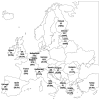Lung recruitment manoeuvre strategies in paediatric intensive care units across Europe
- PMID: 40040904
- PMCID: PMC11873995
- DOI: 10.1183/23120541.00781-2024
Lung recruitment manoeuvre strategies in paediatric intensive care units across Europe
Abstract
Introduction: In severe paediatric acute respiratory distress syndrome (PARDS) lung recruitment manoeuvres (LRMs) may be applied to improve oxygenation, but their application is still controversial. The aim of this survey is to report what the current practice is across European paediatric intensive care units (PICUs).
Methods: An online survey was distributed to PICUs in 19 European countries targeting paediatric intensivists, nurses and respiratory therapists. One reply per unit was allowed.
Results: 151 PICUs out of 276 (54.8%) responded. Of those, 75.9% have more than 300 admissions per year and 45.1% are extracorporeal membrane oxygenation (ECMO) centres. LRMs are employed in 78.9% of surveyed PICUs. Twenty-three out of 105 (21.9%) PICUs have a standardised protocol. LRMs are mainly performed by physicians (99%), supported by nurses (38.4%) and/or respiratory therapists (11.5%). The main reported contraindications are air leak (86.7%), haemodynamic instability (75.2%) and intracranial hypertension (63.8%). Staircase recruitment manoeuvres (SRMs) are the most commonly (69.5%) practiced LRMs, while sustained inflation is used in 44.8% of PICUs, alone or in addition to SRMs. The success of LRMs is measured through oxygenation improvement (oxygenation index or arterial oxygen tension/inspiratory oxygen fraction). Profound hypotension is the most reported complication (49.5%), while 35.2% did not report any complication. Lack of familiarity is the main obstacle to the application of LRMs (67.9%).
Conclusions: To our best knowledge this is the first survey providing an overview of current LRMs application among European PICUs. Practise is diverse among countries and PICUs. Further research is necessary to build stronger evidence to support a more standard application of LRMs.
Copyright ©The authors 2025.
Conflict of interest statement
Conflict of interest: All authors have nothing to disclose.
Figures





Similar articles
-
Lung recruitment manoeuvres for reducing mortality and respiratory morbidity in mechanically ventilated neonates.Cochrane Database Syst Rev. 2021 Mar 30;3(3):CD009969. doi: 10.1002/14651858.CD009969.pub2. Cochrane Database Syst Rev. 2021. PMID: 33781001 Free PMC article.
-
Pediatric intensive care: result of a European survey.Intensive Care Med. 2002 Dec;28(12):1797-803. doi: 10.1007/s00134-002-1532-y. Epub 2002 Oct 29. Intensive Care Med. 2002. PMID: 12447526
-
Pain and sedation management and monitoring in pediatric intensive care units across Europe: an ESPNIC survey.Crit Care. 2022 Mar 31;26(1):88. doi: 10.1186/s13054-022-03957-7. Crit Care. 2022. PMID: 35361254 Free PMC article.
-
Continuous Kidney Replacement Therapy Practices in Pediatric Intensive Care Units Across Europe.JAMA Netw Open. 2022 Dec 1;5(12):e2246901. doi: 10.1001/jamanetworkopen.2022.46901. JAMA Netw Open. 2022. PMID: 36520438 Free PMC article.
-
Effect of lung recruitment maneuver on oxygenation, physiological parameters and mortality in acute respiratory distress syndrome patients: a systematic review and meta-analysis.Intensive Care Med. 2019 Dec;45(12):1691-1702. doi: 10.1007/s00134-019-05821-9. Epub 2019 Nov 7. Intensive Care Med. 2019. PMID: 31701204
References
-
- Pensier J, de Jong A, Hajjej Z, et al. . Effect of lung recruitment maneuver on oxygenation, physiological parameters and mortality in acute respiratory distress syndrome patients: a systematic review and meta-analysis. Intensive Care Med 2019; 45: 1691–1702. doi:10.1007/s00134-019-05821-9 - DOI - PubMed
-
- Constantin JM, Jabaudon M, Lefrant JY, et al. . Personalised mechanical ventilation tailored to lung morphology versus low positive end-expiratory pressure for patients with acute respiratory distress syndrome in France (the LIVE study): a multicentre, single-blind, randomised controlled trial. Lancet Respir Med 2019; 7: 870–880. doi:10.1016/S2213-2600(19)30138-9 - DOI - PubMed
LinkOut - more resources
Full Text Sources
